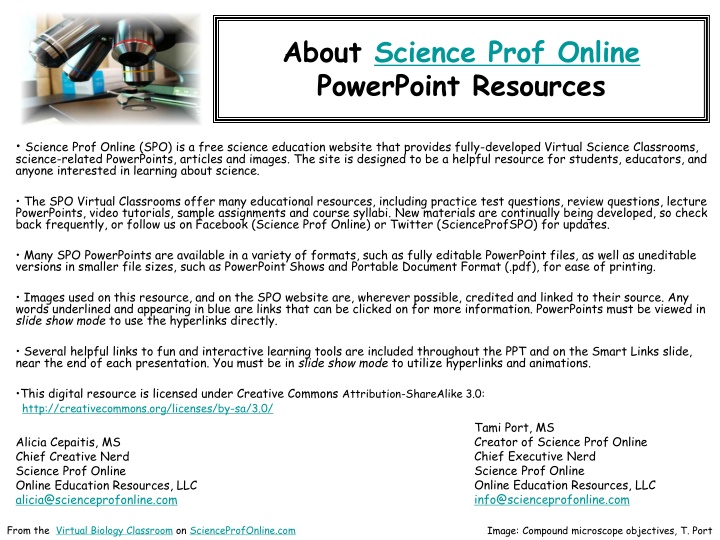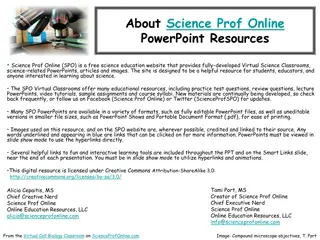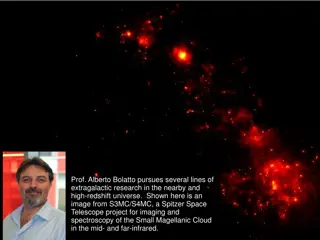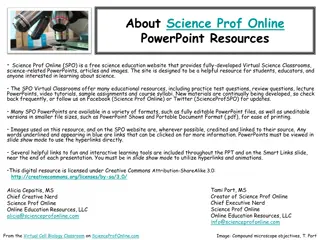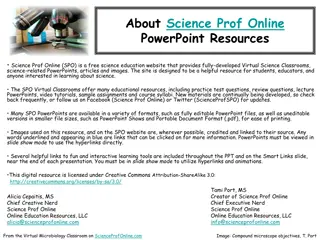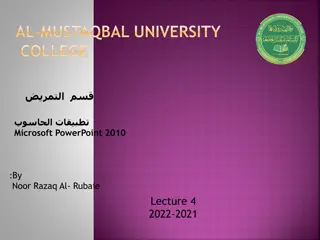About Science Prof Online PowerPoint Resources
Science Prof Online (SPO) is a free website offering Virtual Science Classrooms, science-related PowerPoints, articles, and images. It serves as a valuable resource for students, educators, and science enthusiasts, providing educational materials such as practice test questions, lecture PowerPoints, and video tutorials. The site is continuously updated with new content, including sample assignments and course syllabi. Explore the world of science with SPO!
Download Presentation

Please find below an Image/Link to download the presentation.
The content on the website is provided AS IS for your information and personal use only. It may not be sold, licensed, or shared on other websites without obtaining consent from the author.If you encounter any issues during the download, it is possible that the publisher has removed the file from their server.
You are allowed to download the files provided on this website for personal or commercial use, subject to the condition that they are used lawfully. All files are the property of their respective owners.
The content on the website is provided AS IS for your information and personal use only. It may not be sold, licensed, or shared on other websites without obtaining consent from the author.
E N D
Presentation Transcript
About Science Prof Online PowerPoint Resources Science Prof Online (SPO) is a free science education website that provides fully-developed Virtual Science Classrooms, science-related PowerPoints, articles and images. The site is designed to be a helpful resource for students, educators, and anyone interested in learning about science. The SPO Virtual Classrooms offer many educational resources, including practice test questions, review questions, lecture PowerPoints, video tutorials, sample assignments and course syllabi. New materials are continually being developed, so check back frequently, or follow us on Facebook (Science Prof Online) or Twitter (ScienceProfSPO) for updates. Many SPO PowerPoints are available in a variety of formats, such as fully editable PowerPoint files, as well as uneditable versions in smaller file sizes, such as PowerPoint Shows and Portable Document Format (.pdf), for ease of printing. Images used on this resource, and on the SPO website are, wherever possible, credited and linked to their source. Any words underlined and appearing in blue are links that can be clicked on for more information. PowerPoints must be viewed in slide show mode to use the hyperlinks directly. Several helpful links to fun and interactive learning tools are included throughout the PPT and on the Smart Links slide, near the end of each presentation. You must be in slide show mode to utilize hyperlinks and animations. This digital resource is licensed under Creative Commons Attribution-ShareAlike 3.0: http://creativecommons.org/licenses/by-sa/3.0/ Tami Port, MS Creator of Science Prof Online Chief Executive Nerd Science Prof Online Online Education Resources, LLC info@scienceprofonline.com Alicia Cepaitis, MS Chief Creative Nerd Science Prof Online Online Education Resources, LLC alicia@scienceprofonline.com From the Virtual Biology Classroom on ScienceProfOnline.com Image: Compound microscope objectives, T. Port
How to Use a Compound Microscope Basic Microscopy From the Virtual Biology Classroom on ScienceProfOnline.com Image: The Far Side by Gary Larson
Spontaneous Generation Debate Anton van Leeuwenhoek s Animalcules (Pronounced Lay-ven-hook) 1632 - 1723 As a draper(merchant who sells cloth and dry goods), he used lenses to examine cloth. This probably led to his interest in lens making. He assembled hundreds of microscopes, some of which magnified objects 270 times. As he looked at things with his microscopes, he discovered micro organisms - organisms so tiny that they were invisible to the naked eye. He called these tiny living organisms animalcules . He first described bacteria, protozoans and many cells of the human body. Everett showing how to use the microscope LISTEN to the Radiolabepisode Sperm to learn how Anton let his freak flag fly! Sing It SUPER FREAK!! Images: Leeuwenhoek portrait 1680, Jan Verkolje (I);Replica of Leeuwenhoek microscope, Jacopo Werther; Man with scope, source unknown; Background image is sperm that van Leeuwenhoek drew. From the Virtual Biology Classroom on ScienceProfOnline.com
Anton van Leeuwenhoek: Animalcules (Pronounced Lay-when-hook) WATCH THIS: Pond Life Under the Microscope Below is a poem about Van Leeuwenhoek by Maxine Kumin, from the fantastic book of science-related poetry The Tree That Time Built. The Microscope Anton Leeuwenhoek was Dutch. He sold pincushions, cloth, and such. The waiting townsfolk fumed and fussed, as Anton s dry goods gathered dust. tree_that_time_built.gif He worked, instead of tending store, At grinding special lenses for A microscope. Some of the things He looked at were: mosquitoes wings, the hairs of sheep, the legs of lice, the skin of people, dogs, and mice; ox eyes, spiders spinning gear, fishes scales, a little smear of his own blood, and best of all, the unknown, busy, very small bugs that swim and bump and hop inside a simple water drop. Impossible! Most Dutchmen said. This Anton s crazy in the head! We ought to ship him off to Spain! He says he s seen a housefly s brain! He says the water that we drink Is full of bugs! He s mad, we think! They called him dumkopf, which means dope. That s how we got the microscope. From the Virtual Biology Classroom on ScienceProfOnline.com
Compound Light Microscope The Compound Part Simple microscopes have single magnifyinglens (like a magnifying glass). Compound microscopes have two sets of lenses for magnification. Lens closer to the eye = ocular lens (magnifying power of 10x). Lenses closer to the object being viewed = objective lens. (Most light microscopes used in biology have three or four objective lenses). The Light Part Bright-field light microscopes produce a dark image against brighter, backlit background. Provide a 2-D image. Commonly used to view stained cells. Image: Magnifying lamp use to look for part defects, US Navy; Compound light microscope, Moisey From the Virtual Biology Classroom on ScienceProfOnline.com
Your Microscope Take Care of Your Scope: It is your responsibility to take care of your scope and learn to use it properly. I randomly check scopes to see if they are put away correctly. If yours is not, I may subtract points from your lab grade. ARM Getting Scope Out: When transporting your scope, always hold it with one hand under the base, and one hand around the arm. Putting Scope Away: Clean stage if it is messy, and use lens paper to clean lenses. Shortest objective lens (the one with the red band) should be pointing down toward stage. Use course focus to position stage as low as it can go. BASE ** Now everyone get out their scope ** From the Virtual Biology Classroom on ScienceProfOnline.com Image: Compound light microscope, Moisey
Parts of a Compound Light Microscope From the Virtual Biology Classroom on ScienceProfOnline.com Image: Compound light microscope, Moisey
Magnification & The Ocular Lenses Ocular lens magnifies the specimen 10x. You will always be looking through the ocular and objective lens simultaneously, so multiply ocular magnification x objective power to calculate the Total Magnification (xTM). From the Virtual Biology Classroom on ScienceProfOnline.com Image: Microscope objective lenses, T. Port
Magnification & The Objective Lenses Ocular lens magnifies the specimen 10x. You will always be looking through the ocular and objective lens simultaneously, so multiply ocular magnification x objective power to calculate the Total Magnification (xTM). Rotary nosepiece of your microscope has four objective lenses attached. Shortest lens (red band) should have been pointing down when your scopes were last put away. From the Virtual Biology Classroom on ScienceProfOnline.com Image: Microscope objective lenses, T. Port
Scanning Power Objective Lens Red band around it. Magnifies objects 4x. Q: What is the Total Magnification? ____ TM Usually, if you have trouble finding the specimen at this magnification it means that the stage is too low (use coarse focus to adjust), or that the specimen is not centered From the Virtual Biology Classroom on ScienceProfOnline.com Image: Microscope objective lenses, T. Port
Low Power Objective Lens Has yellow band around it. Magnifies objects 10x. Q: What is the Total Magnification? ____ TM. Q: What does the term parfocal mean? From the Virtual Biology Classroom on ScienceProfOnline.com Image: Microscope objective lenses, T. Port
High Dry Objective Lens Has blue band around it. Magnifies objects 40x. Q: What is the Total Magnification? ____ TM Switch to this lens after getting your specimen in focus at 100xTM. From the Virtual Biology Classroom on ScienceProfOnline.com Image: Microscope objective lenses, T. Port
Confused? Here are links to fun resources that further explain use of the microscope: Microscopy Laboratory Main Pageon the Virtual Microbiology Classroom of Science Prof Online. Compound Microscope Parts and Use videofrom Science ProfOnline. How to Make a Wet Mount of a Cheek Cell video from ScienceProfOnline. Smart Links Play Amoeba, a video game where you are an amoeba that eats and grows. Microscope Mania crossword puzzle. Microscopic Pond Life, an extremely cool collection of videos of a variety of microscopic pond life to the tune of Radiohead s Kid A . From the Virtual Biology Classroom on ScienceProfOnline.com (You must be in PPT slideshow view to click on links.)
